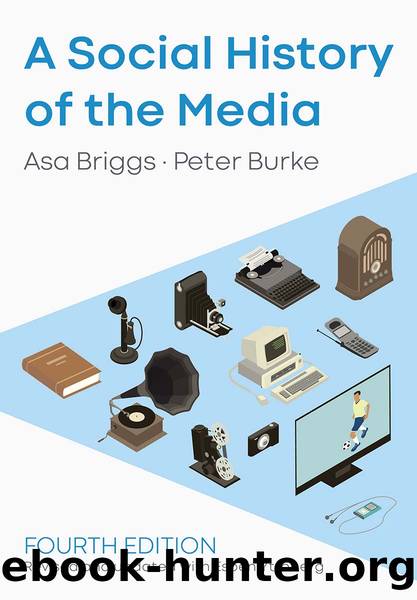A Social History of the Media by Peter Burke & Peter Burke

Author:Peter Burke & Peter Burke [Briggs, Asa & Burke, Peter]
Language: eng
Format: epub
ISBN: 9781509533749
Publisher: Wiley
Published: 2020-06-11T00:00:00+00:00
Films
The origins of motion pictures were mechanical, not electrical, and belonged to the world of toys that had been given names that were far less memorable than Kodak, like Praxinoscope, Phenakistiscope and Kaamatograph. The first man successfully to employ a camera sequence to convey the sense of movement â there had been many earlier unsuccessful attempts â was âEadweard Muybridgeâ, whose chronophotographic series of horse movements, taken for the horse-loving Governor of California in 1872, proved that there were times when a horse was trotting when all its feet were off the ground. âMuybridgeâ, Edward Muggeridge (1830â1904), was an Englishman born at Kingston upon Thames, whose personal experiences included being charged with murder and acquitted. He publicized his photos in Animal Locomotion (1888) and Animals in Motion (1899) and opened a âZoopraxographical Hallâ at the Chicago Columbian Exhibition of 1893, where a photographic display of leaping horses and gymnasts was a great popular attraction. In parallel, a French physiologist, Etienne Marey (1830â1904), publicized his own work in Le Mouvement (1894), and he recorded on a single film multiple images of birds in flight.
In 1894 Edison, who had set up his laboratory at Menlo Park in an earlier Exhibition year, 1876, put on sale his patented kinetoscope, a device that made it possible individually to watch, with an eye-piece, a moving film. Inspired by Muybridge and possibly by Marey, Edison set out to do for the eye what the phonograph could do for the ear. His practical ambition, however, was at first limited: he conceived of the kinetoscope in the context of a peepshow in a penny arcade, with one person at a time paying a coin and âgluingâ his eye to a small peephole through which he might see a girl dancing or two men boxing. Edison did not then believe that using his invention to project images onto a screen would be financially profitable, but between 1893 and 1895 he allowed two of his assistants, W. K. L. Dickson and William Heise, to shoot a number of interesting 20-second films in the worldâs first film studio, the Black Maria. Themes included âBar Room Brawlâ, âSioux Indiansâ and âEdison in Laboratoryâ. Another assistant, Fred Ott, produced the first motion picture to be copyrighted in the United States in January 1894, âKinetoscopic Record of a Sneezeâ.
In November 1895, Max and Emil Skladanowsky screened nine films in Berlin, using what they called a Bioskop system â they included gloved kangaroos engaged in a boxing match. A month later, Louis Lumière (1864â1948), seventeen years younger than Edison, introduced his âcinematographâ, hailed as a nouveauté du jour, to an audience of thirty-five at the Grand Café in Paris, going on in 1896 to present films to a bigger audience at the Empire Music Hall in Londonâs Leicester Square. The London programme was very mixed, beginning with an overture and including a group of Russian dancers and juggling acrobatic acts. One of the films shown was The Arrival of the Paris Express, another Boating in the Mediterranean.
Download
This site does not store any files on its server. We only index and link to content provided by other sites. Please contact the content providers to delete copyright contents if any and email us, we'll remove relevant links or contents immediately.
| Africa | Americas |
| Arctic & Antarctica | Asia |
| Australia & Oceania | Europe |
| Middle East | Russia |
| United States | World |
| Ancient Civilizations | Military |
| Historical Study & Educational Resources |
Magic and Divination in Early Islam by Emilie Savage-Smith;(1240)
Ambition and Desire: The Dangerous Life of Josephine Bonaparte by Kate Williams(1136)
Operation Vengeance: The Astonishing Aerial Ambush That Changed World War II by Dan Hampton(1016)
What Really Happened: The Death of Hitler by Robert J. Hutchinson(931)
Papillon by Henry Charrière(904)
London in the Twentieth Century by Jerry White(891)
Time of the Magicians by Wolfram Eilenberger(885)
Twilight of the Gods by Ian W. Toll(870)
The Japanese by Christopher Harding(853)
Lenin: A Biography by Robert Service(832)
The Devil You Know by Charles M. Blow(819)
Twelve Caesars by Mary Beard(819)
Bohemians, Bootleggers, Flappers, and Swells: The Best of Early Vanity Fair by Bohemians Bootleggers Flappers & Swells- The Best of Early Vanity Fair (epub)(797)
Freemasons for Dummies by Hodapp Christopher;(782)
The Churchill Complex by Ian Buruma(767)
The Rise and Triumph of the Modern Self by Unknown(747)
Napolean Hill Collection by Napoleon Hill(742)
Henry III by David Carpenter;(725)
The Enlightenment by Ritchie Robertson(719)
